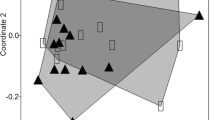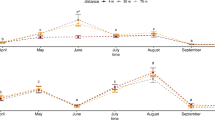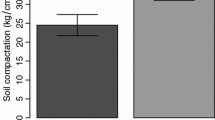Abstract
This study was designed to test the hypothesis that desert ant species that build nests that remain viable at a particular point in space for more than a decade produce soil conditions that enhance microbial biomass and functional diversity. We studied the effects of a seed-harvester ant, Pogonomyrmex rugosus, and two generalist ant species, Aphaenogaster cockerelli and Myrmecocystus depilis, on soil microbial communities. Microbial biomass was higher in P. rugosus-modified soils than in reference soils when soil water content was higher than 3%. Microbial biomass was either higher in reference soils or exhibited no difference in reference soils and nest-modified soils of A. cockerelli and M. depilis. There were differences in microbial functional diversity and microbial community level physiological profiles (MicroResp method) between ant-nest-modified and reference soils of the three ant species on some sampling dates. Temporal patterns of soil microbial communities associated with the ant species resulted from differences in soil moisture, density, and species composition of the annual plant communities associated with the ant nests and in reference areas. Differences in annual plant communities associated with ant nests and surrounding areas resulted in different chemical inputs into the soil organic-matter pools. This study shows that generalizations about the effects of long-lived ant nests on soil biota in arid regions must consider feeding behaviors of the ant species and temporal patterns of rainfall.








Similar content being viewed by others
References
Anderson JE, Domsch KH (1978) Physiological method for quantitative measurement of microbial biomass in soils. Soil Biol Biochem 10:215–221
Anderson TH, Domsch KH (1990) Application of eco-physiological quotients (qCO2 and qD) on microbial biomass from soils of different cropping histories. Soil Biol Biochem 22:251–255
Anderson TH, Domsch KH (1993) The metabolic quotient for CO2 (qCO2) as a specific activity parameter to assess the effects of environmental conditions, such as pH, on the microbial biomass of forest soils. Soil Biol Biochem 25:393–395
Bestelmeyer BT, Wiens JA (2003) Scavenging ant foraging behavior and variation in the scale of nutrient redistribution among semi-arid grasslands. J Arid Environ 53:373–386
Boulton AM, Jaffee BA, Scow KM (2003) Effects of a common harvester ant (Messor andrei) on richness and abundance of soil biota. Appl Soil Ecol 23:257–265
Cammeraat ELH, Risch AC (2008) The impact of ants on mineral soil properties and processes at different spatial scales. J Appl Entomol 132:285–294
Chapman SJ, Campbell CD, Artz RRE (2007) Assessing CLPPs using MicroReSp (TM)—a comparison with biolog and multi-SIR. J Soils Sediments 7:406–410
Chen MM, Zhu YG, Su YH, Chen BD, Fu BJ, Marschner P (2007) Effects of soil moisture and plant interactions on the soil microbial community structure. Eur J Soil Biol 43:31–38
Chew RM (1995) Aspects of the ecology of 3 species of ants (Myrmecocystus spp., Aphaenogaster sp) in desertified grassland in Southeastern Arizona, 1958–1993. Am Midl Nat 134:75–83
Jones JB, Wagner D (2006) Microhabitat-specific controls on soil respiration and denitrification in the Mojave Desert: the role of harvester ant nests and vegetation. Western N Am Naturalist 66:426–433
Jones CG, Lawton JH, Shachak M (1994) Organisms as ecosystem engineers. Oikos 69:373–386
Lei SA (2000) Ecological impacts of seed harvester ants on soil attributes in a Larrea-dominated shrubland. Western N Am Naturalist 60:439–444
MacMahon JA, Mull JF, Crist TO (2000) Harvester ants (Pogonomyrmex spp.): their community and ecosystem influences. Annu Rev Ecol Syst 31:265–291
Meier CL, Bowman WD (2008) Links between plant litter chemistry, species diversity, and below-ground ecosystem function. Proc Natl Acad Sci U S A 105:19780–19785
Nannipieri P, Ascher J, Ceccherini MT, Landi L, Pietramellara G, Renella G (2003) Microbial diversity and soil functions. Eur J Soil Sci 54:655–670
Steinberger Y, Shmida A, Whitford WG (1990) Decomposition along a rainfall gradient in the Judean Desert, Israel. Oecologia 82:322–324
Wagner D, Jones JB (2004) The contribution of harvester the ant nests, Pogonomyrmex rugosus (Hymenoptera, Formicidae), to soil nutrient stocks and microbial biomass in the Mojave Desert. Environ Entomol 33:599–607
Whitford WG (2000) Keystone arthropods as webmasters in desert ecosystems. In: Coleman DC, Hendrix PF (eds) Invertebrates as webmasters in ecosystems. CABI Publishing, New York, pp 25–41
Whitford WG (2001) Invertebrates: their effects on the properties and processes of desert ecosystems. In: Prakash I (ed) Ecology of desert environments. Scientific Publishers, Jodhpur, India, pp 333–356
Whitford WG (2002) Ecology of desert systems. Academic, London
Whitford WG, Depree E, Johnson P (1980) Foraging ecology of two Chihuahuan Desert ant species: Novomessor cockerelli and Novomessor albisetosus. Insect Soc 27:148–156
Whitford WG, Barness G, Steinberger Y (2008) Effects of three species of Chihuahuan Desert ants on annual plants and soil properties. J Arid Environ 72:392–400
Wichern F, Joergensen RG (2009) Soil microbial properties along a precipitation transect in Southern Africa. Arid Land Res Manage 23:115–126
Zak JC, Willig MR, Moorhead DL, Wildman HG (1994) Functional diversity of microbial communities: a quantitative approach. Soil Biol Biochem 26:1101–1108
Acknowledgments
Many thanks to Ms. S. Victor for her useful comments and help. This research was supported by Grant number Y410375-04R-22 from the International Arid Lands Consortium and is a contribution to the Jornada Long-Term Ecological Research Program.
We hereby declare that there is no conflict of interest related to this manuscript.
Author information
Authors and Affiliations
Corresponding author
Rights and permissions
About this article
Cite this article
Whitford, W.G., Ginzburg, O., Berg, N. et al. Do long-lived ants affect soil microbial communities?. Biol Fertil Soils 48, 227–233 (2012). https://doi.org/10.1007/s00374-011-0619-4
Received:
Revised:
Accepted:
Published:
Issue Date:
DOI: https://doi.org/10.1007/s00374-011-0619-4




